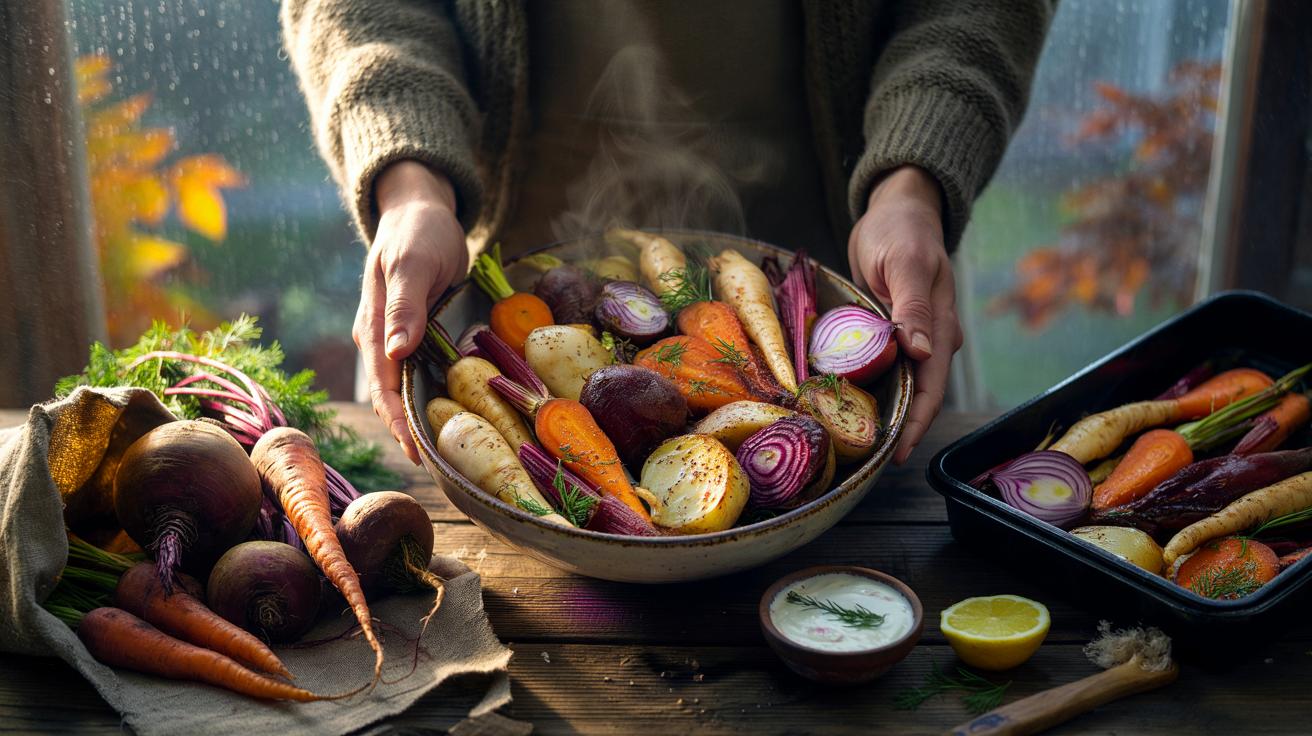The clocks slide back, evenings close in, and the air smells faintly of damp leaves and bus stop brakes. Meals get rushed. Screens glow longer. We crave something warm, heavy, honest. Not a complicated feast. Just food that quiets the nerves and feels like a hand on your shoulder. Root vegetables do that. Not in a flashy way, not with fireworks. With a slow steadiness that matches the season’s pace.
The market’s tarpaulin snapped in the wind, and the October drizzle misted everything into a soft film. A boy weighed muddy carrots on a squeaky scale while his mum tucked parsnips under her arm like a bouquet. I watched a farmer scrub a potato with a brush that had seen better decades, then slice the skin thin enough to lace light through it. When he handed me a sliver, it tasted like rain and stone and something faintly sweet. Not thrilling. Reassuring.
Back home, I tipped a sack of beets on the counter and it thudded like a little drum. The room filled with that iron-rich scent of soil. I sliced, tossed, roasted, and set a bowl on the kitchen table that warmed my palms. Eating felt less like fuelling up and more like returning to a village you half remember. Why do roots feel so stabilising?
Why roots steady us in autumn
You can say it’s carbs, and you wouldn’t be wrong. But it’s not a sugar rush. It’s a gentle slope. Roots like carrots, swede and beetroot carry fibre that slows the ride and keeps blood sugar from yawing about. That quiet steadiness matters when the light fades mid-afternoon and we’re a bit frayed round the edges. There’s also the weight of it — the bowl in your hands, the fork scraping a tray — that signals the body to drop anchor.
Take a Tuesday in Hackney: Julia, who cycles to work, swapped her brittle lunchtime salad for warm roasted roots and lentils. Nothing fancy — carrot coins, fennel seeds, a squeeze of lemon. Her afternoon cravings dialled down. She didn’t bounce from flat white to flat white. One small, n=1 experiment, yes. Still, it chimes with the data: root veg typically carry 2–6g of fibre per 100g and a raft of minerals like potassium, which plays peacekeeper with fluid balance and muscle function. The effect is quieter, not sleepy. More steady than slow.
There’s a seasonal logic at play. As daylight thins, our routines tilt indoors, movement often narrows, and the nervous system can run a tad hot. Solid, warm, slightly sweet foods nudge the parasympathetic side — the body’s “rest and digest” setting. You feel full in a way that’s not about fullness alone. It’s about being satisfied. Roots speak to **steady energy**, and to a human pattern older than streetlights: harvest, store, take your time.
How to cook for grounding, not just comfort
Here’s a tray method that rarely misses. Heat the oven to 200°C with the tray inside. Cut a mix — carrots, parsnips, beetroot, red onions — into chunks about the size of a pound coin in thickness. Toss with olive oil, flaky salt, cracked pepper, and a crushed clove of garlic per person. Slide the veg onto the hot tray so it sizzles on contact. Roast 20 minutes, shake, roast 15 more. Finish with a splash of red wine vinegar and chopped herbs. The vinegar wakes everything up without making it sharp.
Common slips? Peeling away flavour and nutrients — a good scrub often beats a peel. Overcrowding the tray so veg steam instead of crisp. Forgetting to season early and late. And storage matters: keep potatoes in a dark, cool spot in a breathable bag; keep onions apart from them; refrigerate beetroot once trimmed. We’ve all had that moment when the week collapses and dinner becomes toast and a piece of cheese. Let’s be honest: nobody does roasting trays and three sides every night. Aim for one little win — a pan of roots in the fridge turns into bowls, wraps, omelettes, you name it.
When you want food to do more than fill a hole, it helps to think in textures and temperatures, not just flavours. Pair creamy mash with something crunchy, or hot wedges with a cool yoghurt sauce. That contrast lands beautifully on tired days.
“Roots are like batteries for slow days — you charge quietly, then get on with your life,” a grower in Somerset told me, brushing soil from a beet the colour of a low sunset.
- Quick grounding ideas: carrot ribbons with tahini and lemon.
- Five-minute mash: buttered swede with white pepper.
- Brothy beet and barley soup with dill.
- Roasted parsnips with miso glaze.
- Warm new potatoes, mustard, and capers.
Autumn plates as a way of feeling at home
What if dinner wasn’t a performance, but a place to land? Roots invite that kind of cooking. They wait for you. They forgive timing. You can roast them while you fold laundry or send the email you’ve delayed all day. You can turn leftovers into tomorrow’s frittata, or blitz them into a soup that smells like a small pub fire after rain.
I keep thinking about the way the farmer’s knife let light through the potato slice. There’s something devotional in small, repetitive kitchen tasks. Scrubbing, chopping, stirring. *They put your hands to work so your mind can stretch out and breathe.* A pot bubbling like a steady conversation. A tray that crackles when you open the oven door. Not spectacular, just right.
So try one little ritual this week: a bag of carrots and a fennel bulb, or a knobbly celeriac you haven’t used since last winter. See what happens when the house fills with that sweet, earthy perfume. Maybe you’ll eat in silence. Maybe you’ll text a friend a photo of your ridiculous purple beet hands. Maybe you’ll notice that **the pull of the ground** is not a metaphor at all, but a bowl of roasted roots on your lap while the wind rattles the letterbox. There’s **quiet joy** in that.
| Point clé | Détail | Intérêt pour le lecteur |
|---|---|---|
| Fibre + lenteur | Roots offer 2–6g fibre per 100g and a lower, steadier energy release | Fewer spikes and slumps; longer, calmer focus |
| Technique four | Preheated tray at 200°C, don’t overcrowd, finish with acid and herbs | Reliable flavour and texture without fuss |
| Gestes du quotidien | Scrub, not peel; smart storage; cook once, eat twice | Less waste, more ease, better taste across the week |
FAQ :
- Which root vegetables are best for “grounding” meals?Go for a mix: carrots for sweetness, parsnips for perfume, beetroot for depth, potatoes or celeriac for body. Variety brings balance in both flavour and texture.
- How do I stop roasted roots from going soggy?Use a hot preheated tray, give everything space, and cut pieces to a similar size. Salt early, then finish with a little acid. Flip once, not five times.
- Can root veg work when I’m short on time?Yes. Dice smaller to cook faster, or microwave chunks for 3–4 minutes before roasting. A pressure cooker turns beetroot tender in under 20 minutes.
- Are root vegetables too carby for me?They’re carbohydrate-rich, sure, yet their fibre helps slow things down. Pair with protein and healthy fats — yoghurt, beans, eggs, fish — for a meal that feels even steadier.
- What about the skins — eat or peel?Often, wash and keep them. Skins carry flavour and nutrients. Peel only when the skin is tough or damaged, or when the recipe asks for silky texture (like a velvet mash).
First Appeared on
Source link













